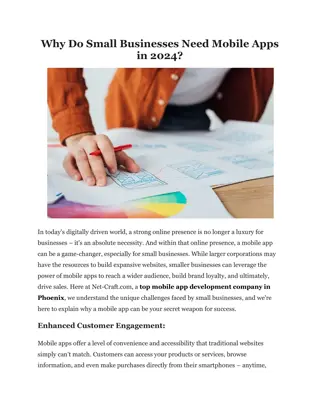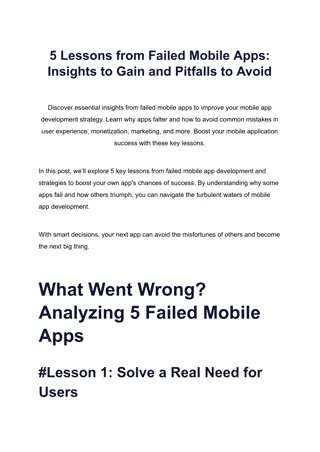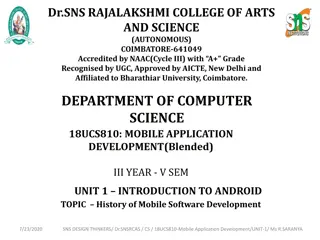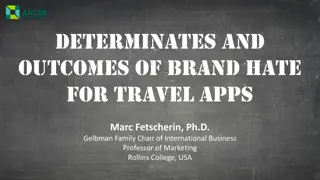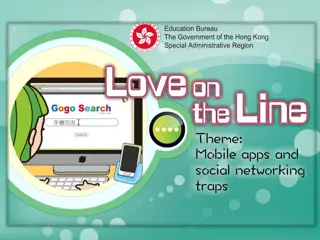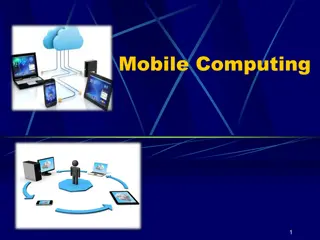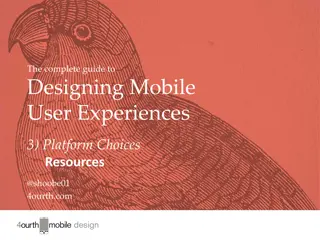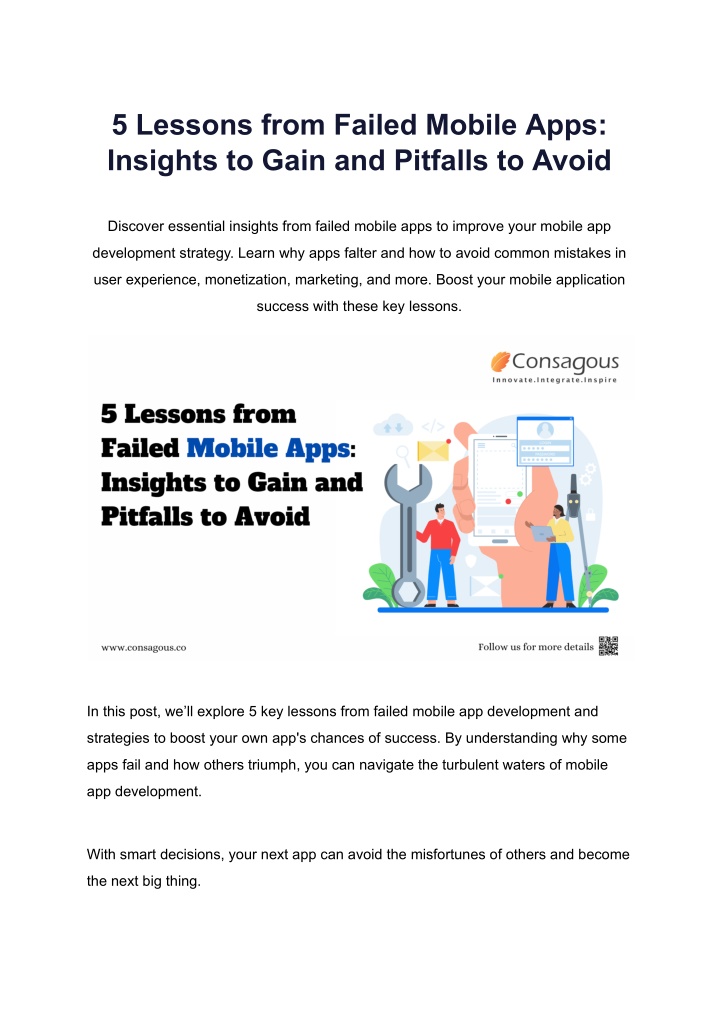
5 Lessons from Failed Mobile Apps_ Insights to Gain and Pitfalls to Avoid
Discover essential insights from failed mobile apps to improve your mobile app development strategy. Learn why apps falter and how to avoid common mistakes in user experience, monetization, marketing, and more. Boost your mobile application success w
Download Presentation

Please find below an Image/Link to download the presentation.
The content on the website is provided AS IS for your information and personal use only. It may not be sold, licensed, or shared on other websites without obtaining consent from the author. If you encounter any issues during the download, it is possible that the publisher has removed the file from their server.
You are allowed to download the files provided on this website for personal or commercial use, subject to the condition that they are used lawfully. All files are the property of their respective owners.
The content on the website is provided AS IS for your information and personal use only. It may not be sold, licensed, or shared on other websites without obtaining consent from the author.
E N D
Presentation Transcript
5 Lessons from Failed Mobile Apps: Insights to Gain and Pitfalls to Avoid Discover essential insights from failed mobile apps to improve your mobile app development strategy. Learn why apps falter and how to avoid common mistakes in user experience, monetization, marketing, and more. Boost your mobile application success with these key lessons. In this post, we ll explore 5 key lessons from failed mobile app development and strategies to boost your own app's chances of success. By understanding why some apps fail and how others triumph, you can navigate the turbulent waters of mobile app development. With smart decisions, your next app can avoid the misfortunes of others and become the next big thing.
What Went Wrong? Analyzing 5 Failed Mobile Apps #Lesson 1: Solve a Real Need for Users One of the most fundamental mistakes unsuccessful mobile app solutions make is failing to address a real pain point or need for users. Without a compelling use case, an app will struggle to attract and retain users no matter how smooth the UI or how advanced the tech is.
For example, in 2020, Quibi launched as a mobile-only video streaming service focused on "quick bite" shows under 10 minutes. Despite raising $1.75 billion in funding, Quibi failed to gain traction and closed down after just 6 months. This flop was largely due to not solving a clear user need - most viewers already access short-form videos easily on YouTube or social apps. The takeaway: Thoroughly research your target users and identify concrete needs your app can fulfill. Don't rely on cool features alone. Solve real problems for real people. #Lesson 2: Deliver Excellent UX Design
Buggy, confusing, or frustrating user experiences are a huge barrier to app adoption and retention. Even if your app addresses a legitimate need, poor UX design will turn users away. Yo, a simple one-tap messaging app, illustrates this misstep. While the app garnered buzz for its novelty, it failed to retain users thanks to an incredibly limited feature set. There was virtually no functionality beyond sending the word "Yo" to contacts. The initial innovation quickly wore off in the face of empty UX. The takeaway: Obsess over UX when designing your app. Conduct extensive user testing to identify pain points and refine experiences. Mobile app development succeeds when users not only download them but continue to use them thanks to enjoyment and value. Common Pitfalls to Avoid
#Lesson 3: Build Sustainable Monetization Strategies Generating steady revenue is essential for any business, including mobile app solutions. Relying solely on upfront purchase fees or ad support is risky. Savvy mobile app developers implement diverse, sustainable monetization strategies. Path, a private social network, exemplifies the pitfalls of faulty monetization. The app charged a monthly subscription fee but never managed to attract enough users to turn a profit. Eventually, Path pivoted to an ad-supported model, but it was a little too late. The takeaway: Consider implementing multiple revenue streams like freemium models, in-app purchases, affiliate programs, etc. And thoroughly evaluate potential models early in the mobile app development process, not as an afterthought.
#Lesson 4: Plan Beyond the Launch Releasing an app is just the first step. Successful apps continually add features, optimize performance, and evolve the user experience post-launch. Apps that fail to plan for the long haul quickly freeze. Secret, an anonymous social sharing app, learned this lesson the hard way. After launch, the app experienced rapid growth. However, the company failed to moderate content or meaningfully expand features effectively. Over time, growth stalled. Eventually, Secret shut down as users lost interest. The takeaway: Create detailed roadmaps for enhancing your app over time. Listen closely to user feedback to identify areas for improvement. And devote resources to continually releasing updates, not just focusing on launch mania.
#Lesson 5: Promote Smartly Across Channels User acquisition can t begin and end with launching on app stores. Successful apps promote across a variety of digital and even traditional channels. Color, a photo-sharing app, flopped in large part due to poor promotion. The app was expected to go viral solely through social buzz. But, it failed to gain much organic traction or execute effective marketing campaigns across platforms. The user base struggled, as most people simply didn t know about the app. The takeaway: Develop comprehensive marketing plans that extend well beyond your launch date. Experiment with paid advertising on platforms like Facebook,
Instagram, and Google. Pitch your app to relevant bloggers and media outlets. Spread the word far and wide! The Rise and Stall of Clubhouse Clubhouse launched in 2020 as an invite-only audio chat app. The platform quickly gained buzz and traction, with over 10 million users in the first year. However, Clubhouse's growth has significantly stalled since 2021. Competitors like Twitter Spaces, Spotify Greenroom, and Facebook Live Audio Rooms have eaten into Clubhouse's market share. These alternatives offer similar functionality. Solve a Real Need - Clubhouse did not foster long-term recurring usage once the novelty wore off. The app lacked engaging features driving habitual use. Deliver Excellent UX - Competitors quickly replicated Clubhouse's functionality, offering similar audio chat experiences. Clubhouse needed a more unique, engaging UX. Build Sustainable Monetization - Clubhouse's lack of a revenue model made it difficult to sustain growth long-term. More revenue streams could have extended its market viability.
Plan Beyond the Launch - Clubhouse did not rapidly iterate or add new features post-launch. More ongoing enhancements could have helped retain users. Promote Smartly - While initial buzz propelled early growth, more marketing was needed to boost awareness and acquisition long-term. The Clubhouse case study highlights that apps must continually evolve the core experience to retain users. One-dimensional platforms are easily outmatched once competitors enter the space. Sustaining growth requires strategic iteration and enhancement post-launch. Putting Lessons into Practice Learning from failure is invaluable, but taking action on those lessons is what leads to success. Here are 5 strategies to put these lessons into practice as you develop your next mobile app solutions: Conduct market research to identify target users and use cases. Don t assume your idea will be universally appealing. Verify a real market need. Prototype and user test continuously throughout mobile application development. Don t wait until after launch to seek user feedback. Refine UX from day one.
Model financial projections taking into account diverse revenue streams. Determine what combination of paid downloads, subscriptions, ads, etc., makes the most sense. Map out a post-launch roadmap during the planning process. Enhancements and new features should be built into your plans from day one. Develop marketing assets and campaigns long before launch. Allow ample time to spread the word across digital/traditional channels. Great apps require great marketing. While nothing can guarantee mobile app development success, avoiding common mistakes and implementing the strategies above will put you on the right path. Learn from failures, plan thoroughly, and keep users at the heart of your efforts. With dedication and smart decisions, your app can avoid the missteps of others and achieve sustainable growth for years to come. Conclusion Learning from past failures is key to mobile app development success. By avoiding common mistakes, you can set your app up for sustainable growth. Be sure to validate demand, optimize UX, diversify monetization models, plan for evolution post-launch, and promote across channels. Keep these lessons in mind on your journey to mobile app mastery. Seek expertise in your Mobile App Journey! While the path to mobile app success is filled with challenges, partnering with seasoned experts can a significant difference.
With over a decade of experience, Consagous Technologies has been at the forefront of the mobile app development landscape. Our team is dedicated to turning app ideas into realities, prioritizing a seamless user experience and robust growth strategies. Through continuous user testing, we refine UX to align closely with user needs. To ensure sustained growth, our mobile app developers combine effective monetization strategies with targeted marketing campaigns. Considering an app venture? Consagous offers a free consultation to provide insights and guidance tailored to your concept. Reach out, us at +1 (213) 257-8054 or Inquiry@consagous.co and let s embark on a successful mobile app journey together.





